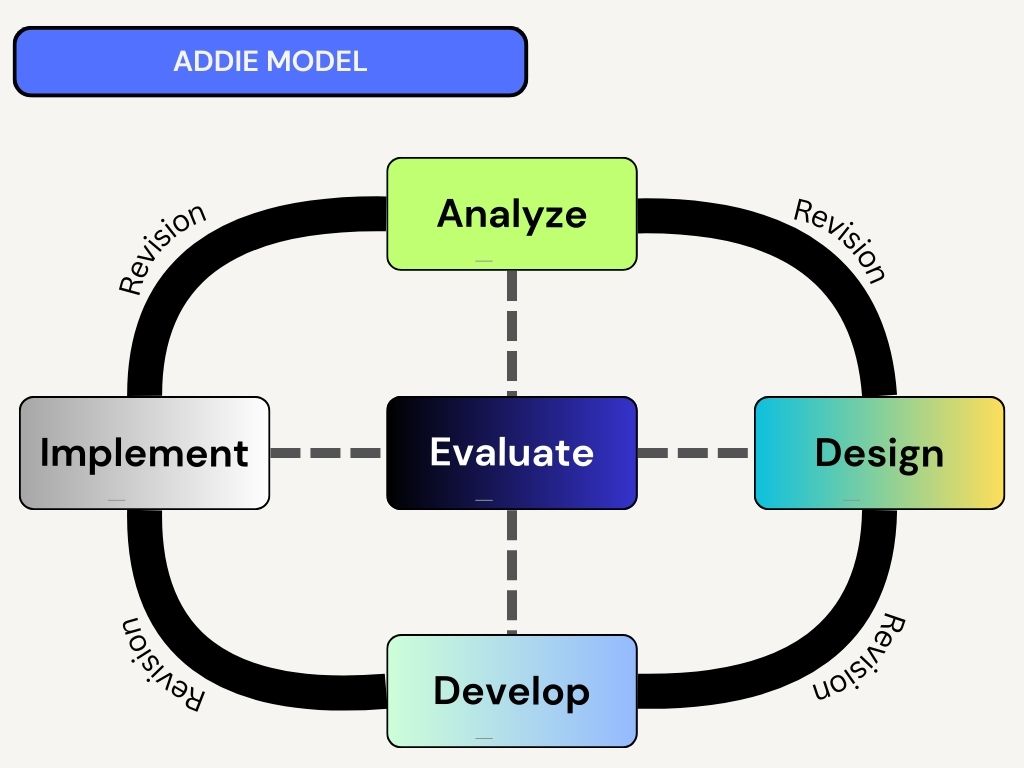The ADDIE Model

Illustration created in Canva
The ADDIE model (Analyze, Design, Develop, Implement, Evaluate) is a systematic framework for product development that has become foundational in instructional design and technology. This iterative process underpins numerous models, allowing flexibility and adaptability in designing instructional products for varied contexts (Branch, 2009; Molenda, 2008). It emphasizes a continuous cycle of improvement, ensuring products are goal-oriented and meet learner needs effectively.
- Analyze: This phase involves identifying the performance gap through a needs assessment (Rossett, 1993) or pinpointing a problem in a business or educational setting (Gilbert, 1978).
- Design: This phase focuses on writing measurable objectives (Mager, 1984) and specifying instructional strategies, media, and learning activities (Gagné et al., 2005).
- Develop: Here, materials and prototypes are created for instructors and learners (Morrison et al., 2019).
- Implement: This phase includes delivering the instruction in its intended context (Greer, 1996).
- Evaluate: Both formative and summative evaluations (Dick et al., 2021) are critical for assessing and refining the product.
References:
- Branch, R. M. (2009). Instructional design: The ADDIE approach. Springer.
- Dick, W., Carey, L., and Carey, J. O. (2021). The systematic design of instruction (9th ed.). Pearson.
- Gagné, R. M., Wager, W. W., Golas, K., and Keller, J. M. (2005). Principles of instructional design (5th ed.). Wadsworth.
- Gilbert, T. F. (1978). Human competence: Engineering worthy performance. McGraw-Hill.
- Greer, M. (1996). The manager’s guide to instructional design. HRD Press.
- Mager, R. F. (1984). Preparing instructional objectives (2nd ed.). David S. Lake Publishers.
- Molenda, M. (2008). In search of the elusive ADDIE model. Performance Improvement, 47(9), 10–13.
- Morrison, G. R., Ross, S. M., Kemp, J. E., and Kalman, H. K. (2019). Designing effective instruction (8th ed.). Wiley.
- Rossett, A. (1993). Training needs assessment. Educational Technology Publications.
Moodle Course and Artifacts
Explore our group project, where we developed a CSS module for customizing Moodle Cloud. This project was part of our instructional design coursework and utilized the ADDIE framework to systematically design and refine the course. The final product was delivered on the Canvas LMS platform, focusing on practical Moodle customization techniques.
View the Moodle Customization Project
Artifacts Using the ADDIE Model
This course was developed using the ADDIE instructional design model. Below are documents from each phase of the process:
ADDIE Reflection
I used the ADDIE model in a group project to create a Bootstrap course for Moodle on Canvas. When we started, our group had ambitious ideas for a subject—creating a whole course to help instructional designers design a Moodle course. By following the steps of the ADDIE model, we continuously refined our project.
During the analysis stage, we focused on identifying the needs of instructional designers. In the design stage, we realized how challenging it would be to include everything we initially planned, so we simplified our approach. As we progressed to the development stage, we recognized the significant amount of content required to meet our objectives, which led us to simplify the course even further. By the time we reached the implementation and evaluation stages, our project was well-prepared and ready to go.
If we had more time to complete the project, the ADDIE model would have been ideal for iteratively designing, developing, and refining every aspect of the course. It provided a structured framework that helped us move from ambitious ideas to a practical, functional course.